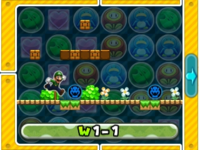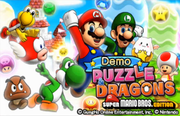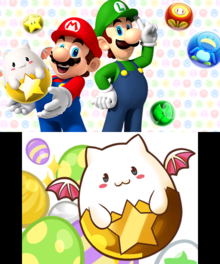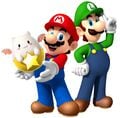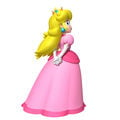Puzzle & Dragons: Super Mario Bros. Edition: Difference between revisions
Lord Falafel (talk | contribs) (Fixed links) Tag: Mobile edit |
|||
| Line 13: | Line 13: | ||
}} | }} | ||
'''''Puzzle & Dragons: Super Mario Bros. Edition''''' is a ''[[Mario (franchise)|Mario]]''-themed puzzle game with [[Genre#RPG|role-playing]] elements from the '' | '''''Puzzle & Dragons: Super Mario Bros. Edition''''' is a ''[[Mario (franchise)|Mario]]''-themed puzzle game with [[Genre#RPG|role-playing]] elements from the ''{{wp|Puzzle & Dragons}}'' series released for the [[Nintendo 3DS]].<ref>McWhertor, Michael (January 7, 2015). [http://www.polygon.com/2015/1/7/7512563/puzzle-dragons-super-mario-bros-nintendo-3ds-gungho Nintendo and GungHo team up for Puzzle & Dragons: Super Mario Bros. Edition]. ''Polygon''. Retrieved January 8, 2015.</ref> Originally, it was released in Japan on April 29, 2015. An overseas release was later confirmed<ref>Puzzle & Dragons NA (January 7, 2015); [https://twitter.com/PuzzDragNA/status/553066472348467201 Puzzle & Dragons NA on Twitter: "Details are forthcoming, but an overseas release of Puzzle & Dragons Super Mario Edition via Nintendo has been announced."]. ''Twitter''. Retrieved May 5, 2015.</ref>, and announced during the January 2015 Nintendo Direct to be released together with ''{{wp|Puzzle & Dragons Z + Super Mario Bros. Edition|Puzzle & Dragons Z}}'' as '''''Puzzle & Dragons Z + Puzzle & Dragons: Super Mario Bros. Edition'''''.<ref name="Trailer">Nintendo. (January 14, 2015). [https://www.youtube.com/watch?v=W2BqbedaSg4 Nintendo 3DS - Puzzle & Dragons Z Teaser Trailer]. ''YouTube''. Retrieved January 14, 2015.</ref> The bundled game was released in Europe on May 8th, 2015, in Oceania on May 9th, 2015, and in North America on May 22nd, 2015. | ||
==Story== | ==Story== | ||
Revision as of 13:59, February 26, 2020
Puzzle & Dragons: Super Mario Bros. Edition is a Mario-themed puzzle game with role-playing elements from the Puzzle & Dragons series released for the Nintendo 3DS.[1] Originally, it was released in Japan on April 29, 2015. An overseas release was later confirmed[2], and announced during the January 2015 Nintendo Direct to be released together with Puzzle & Dragons Z as Puzzle & Dragons Z + Puzzle & Dragons: Super Mario Bros. Edition.[3] The bundled game was released in Europe on May 8th, 2015, in Oceania on May 9th, 2015, and in North America on May 22nd, 2015.
Story
The story, from the introduction of the game:
| American version | British version |
|---|---|
|
|
When Mario arrives, a red Toad appears to inform Mario that Princess Peach has been kidnapped by Bowser once again. There was even a message left by Bowser:
Bowser's message, from the introduction of the game:
| American version | British version |
|---|---|
|
|
As it turns out, Bowser and his Koopa Troop heard about the Orbs and launched an attack on the Mushroom Kingdom. Bowser's magician, Kamek, is stealing the power of the Orbs for unknown reasons, casting a spell that's causing the Mushroom Kingdom to overflow with all kinds of Orbs.
To save Princess Peach, Mario would have to use the power of the Orbs to rescue her. The Red Toad joins him to help out along the way. During Mario's adventure, he will encounter many enemies and challenges, face the Koopalings, and recruit enemies trapped in Baddie Blocks that would become allies in his quest to save the princess. Bowser had also kidnapped Yoshi and his friends, but Mario is able to rescue them along the way. Later, he also finds Bowser Jr. and Kamek in several towers but defeats Bowser Jr in each of them as Kamek worries.
After Mario reaches Bowser's Castle and defeats Bowser, Bowser summons the Koopalings and Bowser Jr. in an effort to defeat Mario. Impressed that Mario was able to defeat him and the Koopalings with the power of the Orbs, he vows to face him again once he gets "his full powers", then leaves. Princess Peach is saved and peace once again is restored to the Mushroom Kingdom.
Characters
- Mario
- Luigi
- Princess Peach
- Bowser
- Koopalings
- Kamek
- Bowser Jr.
- Toads
- Yoshis
- Winged Yoshis
- Rosalina
- Tamadra
Gameplay
The gameplay of Puzzle & Dragons: Super Mario Bros. Edition is like that of other Puzzle & Dragons games, it is a tile matching game with elements of a monster collecting RPG. The player creates teams by picking from an array of enemies and allies then play in courses where they solve a tile-matching puzzle that determines how powerful their teammates' attacks are on waves of enemies.
Puzzles
Courses consist of certain numbers of enemy waves, each with their own offensive and defensive statistics. The player must clear all of the enemy waves without having their team's total HP drop to zero. The game's screen is split, with the enemies on the top screen, and a 6-by-5 tile grid appearing on the bottom screen.
Courses are played out in a turn-based style. The player's turn consists of activating any Skills from any of their teammates if available then attempting to make a match of three or more Orbs on the Orb field. The Orbs are of five colors representing the elemental attributes of the enemies (Fire, Water, Wood, Light, and Dark) as well as Heart Orbs that represent life recovery. The player drags an Orb with ![]() to adjacent positions, swapping with the Orb already there. As long as the player does not let go of the Orb, they can move it as much as necessary within five seconds once they start moving it, allowing them to arrange for Combos in a single turn. After completing this, all matched Orbs are removed from the Orb field and accounted for as damage. The Orb field then cascades all Orbs down and fills the Orb field once more; this may result in more Combos, known as "skyfall combos".
to adjacent positions, swapping with the Orb already there. As long as the player does not let go of the Orb, they can move it as much as necessary within five seconds once they start moving it, allowing them to arrange for Combos in a single turn. After completing this, all matched Orbs are removed from the Orb field and accounted for as damage. The Orb field then cascades all Orbs down and fills the Orb field once more; this may result in more Combos, known as "skyfall combos".
Damage is based on what colors were matched in the Combos: for example, a basic combo of three red (Fire) Orbs will have any teammates that is Fire-attribute deal its damage equal to its base attack (ATK) to one enemy. When Heart Orbs are matched in a Combo, it restores health to the team based on the team's total health recovery stat (RCV). Combos of more than three Orbs will increase the damage dealt for each additional Orb. Making multiple Combos on the same turn will boost all damage or healing for all teammates regardless of colors matched, while separate combos of the same color further multiply the damage dealt. Single combos of five or more Orbs will activate an attack that hits all enemies on the field. Certain Leader or Awoken Skills may also change damage dealt, so long as the particular parameters are met. Damage is dealt to a single monster, generally determined by the game is the best attack. Damage will be affected by both the enemies' defense power and its attribute, for Fire damage against a Fire enemy will work, but will be boosted against a Wood enemy and decreased against a Water enemy, and so forth in a rock-paper-scissors relationship; Light and Dark enemies are solely weak to the other type. The player can force damage to go a a single enemy to selecting it with ,
,
or
.
After the player finishes their turn, a counter on each of the enemies drops by one. If one of these counters gets to zero, that enemy is given a turn to attack, and the counter resets to a predefined value. If the player does not end their turn on a successful match, the enemies' attack counter advances once while any timers for the player do not change (statuses imposed by enemies are affected, though). When an enemy's HP drops to zero, the enemy drops out from battle, and there's a chance that it will leave an item. Once all enemies in a battle are defeated, the player is rewarded with experience points and Coins, then moves to the next battle until eventually reaching the boss battle at the end of the course.
Teams
The player can create teams to use in courses, either at Toad Houses or before entering a course. Each team consists of six characters: a Leader, a Helper, and four other teammates. The characters are displayed as cards, with the color of the card matching their attribute (as well as the Orb type on the top-left corner of their card). If a teammate has a secondary element, or sub-attribute, it appears on the bottom-right corner of their card. The player can arrange teammates by dragging their cards with ![]() and dropping them into slots on the top of the touch screen: Leaders can only be placed on the far left slot, but any other teammates can be placed in any of the four slots right of it. Helpers can be selected only when entering a course. The player can create up to six different teams. Teammates that are placed in teams are shown with an "M" symbol on the top-right corner of their card.
and dropping them into slots on the top of the touch screen: Leaders can only be placed on the far left slot, but any other teammates can be placed in any of the four slots right of it. Helpers can be selected only when entering a course. The player can create up to six different teams. Teammates that are placed in teams are shown with an "M" symbol on the top-right corner of their card.
Leaders consist of either Mario or Luigi in one of their forms. Leaders provide the team with Leader Skills, Skills that automatically activate when certain criteria are met: having teammates of a certain attribute, clearing a certain amount or types of Orbs, clearing a certain amount of Combos, or keeping the team's total HP at a certain amount. Most Leader Skills in the game raise ATK in some form, while others raise HP and/or RCV in addition.
Helpers are teammates on the far fight side and have Helper Skills that also boost their team's stats. Helper Skills function the same as Leader Skills. Helpers are selected when the player enters a course. Helpers consist of any color of Toad, Yoshi, Winged Yoshi, and any form of Bowser, Peach, and Rosalina. The opposite brother of the Leader can also be selected as a Helper: if the player has Mario as Leader, Luigi can be selected as the Helper only (the player cannot have the same brother as Leader and Helper).
The player can have up to 300 different teammates in their Ally Box, a listing of all of their teammates. Should the player exceed that limit by obtaining more teammates in a course, they will not be able to enter any courses until they part ways with them or power up other allies at Toad Houses. Parting ways with a teammate removes them from the player's Ally Box. A player cannot part ways with any Leader, Helper, Bowser Jr., or Koopaling.
Teammates can be sorted in nine ways, and can be done while in the Ally Box, at Toad Houses, before entering a course or modifying one's Player Card. The player can enable or disable Orb types to hide teammates of those attributes (excluding sub-attributes). Teammates cannot be sorted in reverse order.
| Sort Type | Description |
|---|---|
| Received | Order of when teammates join the player's party, with the earliest ones listed at the top. |
| Changes | Order of teammates that can undergo transformations, then teammates that have transformed as far as they can or cannot be transformed at all. Listed in order of attribute types otherwise: Fire, Water, Wood, Light, and Dark. |
| Lv. | Order of the teammates' levels, from highest to lowest. |
| HP | Order of the teammates' HP, from highest to lowest. |
| ATK | Order of the teammates' attack power, or ATK, from highest to lowest. |
| RCV | Order of the teammates' healing power, or RCV, from highest to lowest. |
| Awoken | Order of teammates with Awoken Skills, then teammates that have not been awoken yet, then teammates that cannot be awoken at all. Listed in order of attribute types otherwise. |
| Attribute | Order of teammates listed by attribute type: Fire, Water, Wood, Light, and Dark. |
| Order of teammates that have plus bonuses, additional stats earned by powering up, from highest to lowest. |
Courses
When the player selects a course, they can choose which team they wish to use (by pressing or
), select their Helper, then confirm their selection before entering the course.
In addition to fighting enemies throughout a course, the player may come across ? Blocks, which can hold Coins, 1-Up Mushrooms, Transformation Items, or Skill Items. Opening them requires the player to clear a certain amount of Orbs, make a certain amount of combos, and/or to arrange Orbs horizontally or vertically on the Orb field within a set amount of turns. ? Blocks will open only if the player successfully satisfies any and all conditions.
The player may also encounter a branching path in a course, with two different colored Orbs hovering above each path, representing which Orb color the player needs to clear most of from the Orb field to take its path: for example, if the player wishes to take the path with a Fire Orb above it, they will need to clear more Fire Orbs than other Orb types to proceed. The player will remain at the branching path until they clear either Orb colors at that branching path, and the player's Skill counter will not decrease until they do so (the player can use Skills that change Orb types, however). What appears at the path can vary from signs, Warp Pipes, to Gold Blocks. Proceeding on a path with a sign allows the player to continue on the "main" path, while entering Warp Pipes takes them to different areas with ? Blocks and/or different types of enemies (but not always) before returning to the main path. Gold Blocks in branching paths do not show which Orb type the player needs to clear most of, but clearing with the right Orb type will cause the Gold Block to produce a Beanstalk, taking the player to another area. If the player clears the same amount of Orb types for a Gold Block as a Warp Pipe or a sign, the player automatically takes the path of the latter instead.
Once the boss battle is cleared, the player earns the various rewards earned throughout the course (the player can still earn them even after exiting the course before completing it). If the player's team's HP drops to zero, they have the option to use 1-Up Mushrooms to continue where they just lost, refilling their HP and resetting the entire Orb field, or to exit the course (the player will still keep any items collected before being defeated). Once the course is cleared, the next course unlocks.
Status effects
The player's team and enemies can use certain types of Skills to inflict status effects.
| Name | Used by | Effect |
|---|---|---|
| Absorb | Both | Absorbs damage of an attribute to replenish HP. |
| ATK Up | Both | Raises attack power. |
| Bind | Enemy team | Immobilizes a teammate on the player's team for a certain amount of turns. |
| Blind | Enemy team | Changes Orbs on the player's Orb field black, making it difficult for the player to identify Orb types. Moving or touching an Orb will turn it back to normal. |
| Coin Boost | Player team | Increases the amount of coins to be won for a battle. |
| Def Down | Player team | Lowers defense power. |
| Def Up | Both | Raises defense power. |
| Delay | Player team | Delays the turn count of all enemies by a certain amount. |
| Poison | Enemy team | Gradually depletes the player's total HP every turn until winning (or losing) a battle. |
| Status Guard | Enemy team | Blocks against status effects (Def Down, Delay). |
| Timer Reduce | Enemy team | Reduces the amount of time the player can move Orbs on the Orb field. |
| Skill Delay | Enemy team | Increases the amount of turns the player's team can use their Skills. |
Controls
Menus
- Select:
/
- Confirm:
- Back:
- World Map:
- Switch from Normal Worlds to Special Worlds:
or
- Switch from Normal Worlds to Special Worlds:
- Menu:
Course/Team Menus
- Edit Team:
- Select Team:
or
- Sort:
During courses
- Move Orb: Drag and let go of

- Select Target:
,
,
or
- Skill Menu:
- Map:
- Menu:
Worlds
The game has eight worlds with a world map similar to the New Super Mario Bros. series. There are Toad Houses at the beginning of each world, as well as towers (and ghost houses), with a castle and airship as the last two courses at the end of the first seven worlds.
There are 100 courses in the main game. When the player completes the game, more difficult, Special World versions of the regular worlds are unlocked. The themes of the Special Worlds remain the same like the regular worlds, but their maps are colored slightly differently. The challenges and the items dropped from ? Blocks in courses are different, and the enemies are stronger as well.
Normal Worlds
| World 1 | World 2 | World 3 | World 4 |
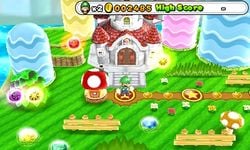
|
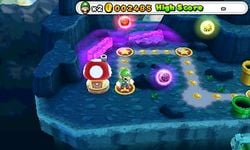
|
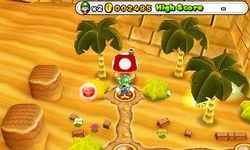
|
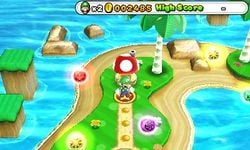
|
| World 5 | World 6 | World 7 | World 8 |
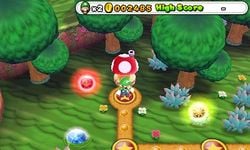
|
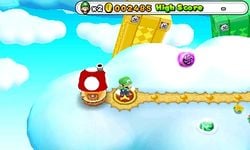
|
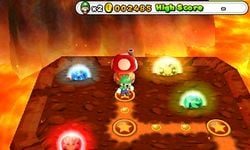
|

|
Special Worlds
| ★World 1 | ★World 2 | ★World 3 | ★World 4 |
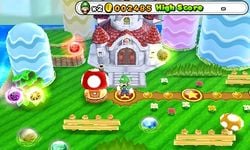
|
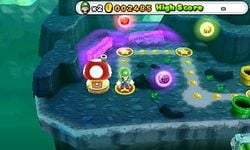
|
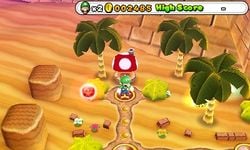
|

|
| ★World 5 | ★World 6 | ★World 7 | ★World 8 |
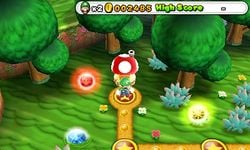
|
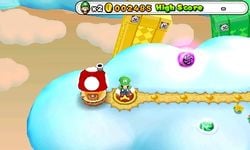
|

|

|
Leaders and Helpers
The player can use Mario or Luigi (and fifteen of their power-up forms) as Leaders of a team. Helper characters will also join the player after clearing levels or worlds. Any Leader or Helper can also appear for the player in their PuzzleFriend list, when players exchange their Player Cards via StreetPass or Local Play. For a complete listing of every character that can be turned into allies, see: List of characters in Puzzle & Dragons: Super Mario Bros. Edition
Mario
| Small Mario | Super Mario | Ice Mario | Raccoon Mario | Fire Mario |
|---|---|---|---|---|

|

|
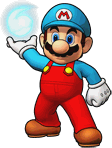
|
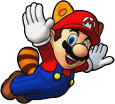
|
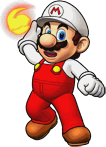
|
| Available at start. | Unlocked by clearing World 1- |
Unlocked by clearing World 1. | Unlocked by clearing World 2- |
Unlocked by clearing World 3- |
| Boo Mario | Penguin Mario | Flying Squirrel Mario | Bee Mario | Statue Mario |

|
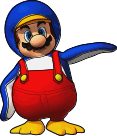
|
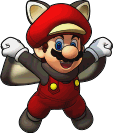
|
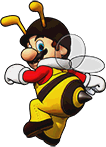
|

|
| Unlocked by clearing World 4- |
Unlocked by clearing World 5. | Unlocked by clearing World 6. | Unlocked by clearing World 7. | Unlocked by clearing ★World 1. |
| Cat Mario | Rock Mario | Double Mario | Metal Mario | Gold Mario |
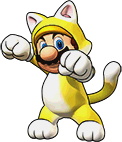
|
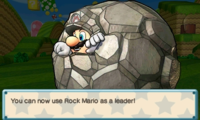
|
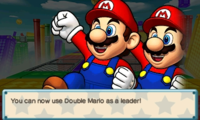
|
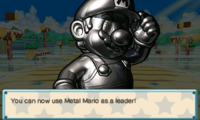
|
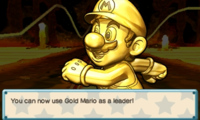
|
| Unlocked by clearing ★World 3. | Unlocked by obtaining an A rank or higher in Course 1 of the Fixed Challenge mode in Score Attack. | Unlocked by obtaining an S rank or higher in Course 2 of the Fixed Challenge mode in Score Attack. | Unlocked by obtaining an S rank or higher in Course 3 of the Fixed Challenge mode in Score Attack. | Unlocked by obtaining an S rank or higher in Course 4 of the Fixed Challenge mode in Score Attack. |
| Boomerang Mario | White Tanooki Mario | |||
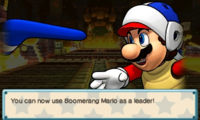
|
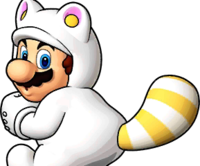
|
|||
| Unlocked by obtaining an SS rank or higher in Course 5 of the Fixed Challenge mode in Score Attack. | Available only after losing nine lives at attempting a course. |
Luigi
| Small Luigi | Super Luigi | Ice Luigi | Fox Luigi | Fire Luigi |
|---|---|---|---|---|

|

|
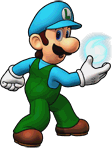
|
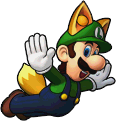
|

|
| Available at start. | Unlocked by clearing World 1- |
Unlocked by clearing World 1. | Unlocked by clearing World 2- |
Unlocked by clearing World 3- |
| Boo Luigi | Penguin Luigi | Flying Squirrel Luigi | Bee Luigi | Statue Luigi |
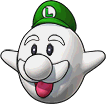
|

|
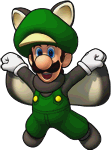
|

|

|
| Unlocked by clearing World 4- |
Unlocked by clearing World 5. | Unlocked by clearing World 6. | Unlocked by clearing World 7. | Unlocked by clearing ★World 2. |
| Cat Luigi | Rock Luigi | Double Luigi | Metal Luigi | Gold Luigi |
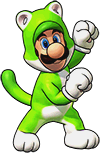
|

|
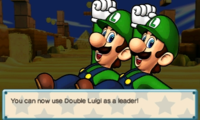
|
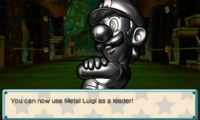
|
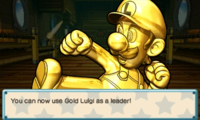
|
| Unlocked by clearing ★World 4. | Unlocked by obtaining an A rank or higher in Course 1 of the Free Challenge mode in Score Attack. | Unlocked by obtaining an S rank or higher in Course 2 of the Free Challenge mode in Score Attack. | Unlocked by obtaining an S rank or higher in Course 3 of the Free Challenge mode in Score Attack. | Unlocked by obtaining an S rank or higher in Course 4 of the Free Challenge mode in Score Attack. |
| Boomerang Luigi | White Kitsune Luigi | |||

|
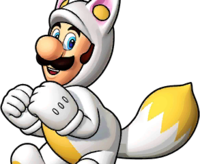
|
|||
| Unlocked by obtaining an SS rank (S+) or higher in Course 5 of the Free Challenge mode in Score Attack. | Available only after losing nine lives at attempting a course. |
Toads
| Red Toad | Green Toad | Blue Toad | Yellow Toad | Purple Toad |
|---|---|---|---|---|

|

|

|

|

|
| Available at start. | Unlocked by clearing World 1-1. | Unlocked by clearing World 1-2. | Unlocked by clearing World 1-4. | Unlocked by clearing World 1-6. |
Yoshis
| Green Yoshi | Red Yoshi | Light-blue Yoshi | Purple Yoshi | Yellow Yoshi |
|---|---|---|---|---|

|
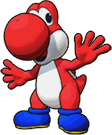
|

|

|
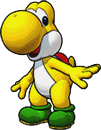
|
| Unlocked by clearing World 5- |
Unlocked by clearing World 6- |
Unlocked by clearing World 6- |
Unlocked by clearing World 7- |
Unlocked by clearing World 7- |
Bowser
| Bowser | Dry Bowser | Bowser the Koopa King |
|---|---|---|
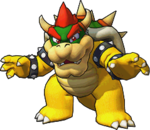
|
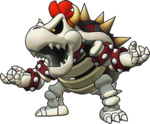
|
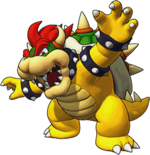
|
| Unlocked by clearing World 8. | Unlocked by clearing ★World 8. | Unlocked by clearing ★World 8. |
Peach
| Peach | Super Peach |
|---|---|

|

|
| Unlocked by clearing World 8. | Unlocked by clearing ★World 8. |
Rosalina
| Rosalina | Super Rosalina |
|---|---|
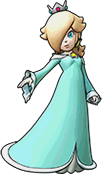
|

|
| Unlocked by clearing ★World 2- |
Unlocked by clearing ★World 5. |
Winged Yoshis
| Green Winged Yoshi | Red Winged Yoshi | Light-blue Winged Yoshi | Yellow Winged Yoshi | Purple Winged Yoshi |
|---|---|---|---|---|

|
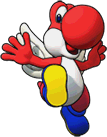
|
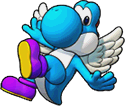
|

|
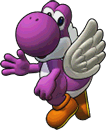
|
| Unlocked by clearing ★World 3- |
Unlocked by clearing ★World 4- |
Unlocked by clearing ★World 5- |
Unlocked by clearing ★World 6- |
Unlocked by clearing ★World 7- |
Enemies
Note that all enemies and bosses in this game can also become allies to the player. Some of the enemies as seen in this list are reused for boss battles, but can sometimes be a bit stronger. Names in italics are names used in the British English version.
Enemies and bosses have a colored health bar beneath them with an Orb next to it that represents its main attribute (Fire, Water, Wood, Light, and Dark). An enemy will take more damage depending on the attribute that is strong or weak against another attribute. For example: Fire is weak against Water, but is strong against Wood; Water is weak against Wood, but is strong against Fire; Wood is weak against Fire, but is strong against Water. Light and Dark attributes are equally weak and strong to each other, but inflict normal damage to the other three attributes.
For more information about enemies, see: List of characters in Puzzle & Dragons: Super Mario Bros. Edition
Bosses
Major bosses
The following bosses are unique in that they're one of a kind, and will never join the player under normal conditions. When these bosses do join the player, the player is not able to part ways or depower any of them, and they stop appearing as enemies as well.
|
|
Generic bosses
The following generic enemies "only" appear as bosses. Unlike the major bosses, these bosses have a very small chance to join the player when defeated, and they'll always appear as enemies, regardless of whether or not they're in the player's party.
|
|
Items
Throughout the game, there are items that can be collected to help raise the levels of the player's teammates.
For a full list of which enemies drop which items, see: List of item drops in Puzzle & Dragons: Super Mario Bros. Edition
Transformation Items
Transformation items are used to transform teammates that are not Leaders or Helpers into stronger forms, allowing them to use stronger versions of their Skills. Transforming a teammate resets their Skill Level back to 1.
With the digital update to version 2.0, each Koopaling can be transformed into two other forms mutually exclusive from each other. Once any of the Koopalings are transformed, their Awoken Skill is replaced with a new one, depending on which form the player chooses, and their form can be switched to their other form and back, as long as the player has enough Transformation Items for them. However, much like with any generic ally, it is impossible to revert the Koopalings back to their original forms.
|
|
|
Skill Items
Skill Items are used to raise Skill levels of characters, reducing the amount of turns needed to use Skills. Ordinary Skill Items are used to raise Skill levels from 1 to 4, while rarer, "Grand" or "Rare" Skill Items are used to reach levels 5 through level 7, the maximum.
For a full list of how many Skill Items are needed to raise a character's Skill level, see: List of Skill upgrades in Puzzle & Dragons: Super Mario Bros. Edition
| Item | Description | Item | Description |
|---|---|---|---|
Comet Medal |
Raises the Skill levels of both forms of Rosalina and all types/forms of Cheep Cheeps and Bloopers from Level 1-4. |  Grand Comet Medal |
Raises the Skill levels of teammates that require Comet Medals further, from Level 5-7. |
Fruit (Berry - British English) |
Raises the Skill levels of all Yoshi and Winged Yoshi colors; all types/forms of Koopa Troopas, Koopa Paratroopas, Buzzy Beetles, Para-Beetles; Rock/Double/Metal/Gold/Boomerang Mario/Luigi (excluding Rock Luigi) from Level 1-4. |  Rare Fruit (Rare Berry - British English) |
Raises the Skill levels of teammates that require Fruits further, from Level 5-7. |
Gold Mushroom |
Raises the Skill levels of all Toad colors, and all types/forms of Goombas and Piranha Plants from Level 1-4. |  Grand Gold Mushroom |
Raises the Skill levels of teammates that require Gold Mushrooms further, from Level 5-7. |
Green Star Coin |
Raises the Skill levels of all forms of Luigi, Spinies, and all types/forms of Bullet Bills, Wigglers, Chain Chomps and Flame Chomps from Level 1-4. |  Grand Green Star Coin |
Raises the Skill levels of teammates that require Green Star Coins further, from Level 5-7. |
Spiky Shell (Bowser's Shell - British English) |
Raises the Skill levels of all Magikoopa types, Boom Boom, the Koopalings, Bowser Jr.; all three forms of Bowser, and Rock Luigi from Level 1-4. |  Grand Spiky Shell (Grand Bowser's Shell - British English) |
Raises the Skill levels of teammates that require Spiky Shells further, from Level 5-7. |
Star Coin |
Raises the Skill levels of most forms of Mario, and all types of Hammer Bros., Coin Coffers, Thwomps and Whomps from Level 1-4. |  Grand Star Coin |
Raises the Skill levels of teammates that require Star Coins further, from Level 5-7. |
Super Star |
Raises the Skill levels of both forms of Peach, Bob-ombs, and all types/forms of Lakitus and Boos from Level 1-4. |  Grand Super Star |
Raises the Skill levels of teammates that require Super Stars further, from Level 5-7. |
Other items
|
|
|
? Block items
There are ? Blocks in most courses that give out items to the player if they complete certain objectives by arranging Orbs on the Orb field (making a match in a line either vertically or horizontally, matching a certain number of Orbs (in a group) or making a certain number of combos) in the allotted number of turns.
Course information
Course maps
The player can see a cut-out of Mario or Luigi traversing on a course from one point to the next on the touch screen, such points consisting of enemy waves (blue Bowser icons), ? Blocks, branching paths and boss battles (large Bowser icons). By pressing during the player's turn, they can view their current position as well as the stop ahead of them. This page shows maps for every course (and Special World counterparts if they differ).
Course types
Each course in Puzzle & Dragons: Super Mario Bros. Edition has a certain configuration of Orbs on the Orb field. All six types of Orbs can appear at once, though some courses may disable elemental Orbs or even Heart Orbs.
Secret exit courses
Several courses contain alternate exits to unlockable courses. Such courses involve using certain teammates's Skills to change Orbs to a color not present on the Orb field normally to match most orbs of that kind at branching paths.
Plus bonuses
When the player powers up an ally in at the Power Up spot at Toad Houses, they may sometimes earn plus stats next to their current stats in the form of stars. Each depowered ally has a 20-25% chance to produce a plus, or star, for another ally.
Damage calculations
Score Attack
- Main article: Score Attack
Score Attack is a mode where the player must defeat all the enemies in a course within a time limit. After clearing the boss battle at the end, the player earns a rank, and their high score. With the digital update to version 2.0, the player can unlock five different forms of Mario or Luigi when clearing courses with high enough ranks.
StreetPass/Local Play
StreetPass and Local Play are supported in this game, where players can exchange their Helpers assigned to their Player Cards with others.
A Player Card is a general profile of the player that can be created at anytime outside courses from the menu. It shows the player's nickname, their comment (if any), their current team and their stats, as well as the Helper they wish to assist other players with. As of version 2.0, the player's highscores and ranks earned from the Fixed and Free Challenges from Score Attack, if any, are also displayed. Once a player creates a nickname for their Player Card, it cannot be changed.
Once the player's Player Card is prepared, it can be traded with other players via Local Play or StreetPass exchange. If two players have StreetPass activated, their Player Cards will automatically be exchanged. StreetPass is tuned off by default, but can be activated or deactivated at anytime from the game's title screen. For two players to exchange Player Cards via Local Play, each player must have a copy of the game, as well as separate Nintendo 3DS systems. By selecting "Trade Player Cards" from the Player Card menu, then selecting "Start local wireless", then selecting "Trade with this partner", the two players can trade Player Cards with each other. Local Play is unlocked after progressing through a certain amount in the game, however.
Any Player Cards the player receives are added to their PuzzleFriend list, found at the Player Card menu. Any teammates registered on Player Cards in this list can be used as Helpers for the player within the main game. Should a player's Helper change (by gaining new levels for themselves or their Skills, or switched out with another teammate), the Helper will be updated for other players when the same players exchange their Player Cards again.
Demo
On April 30, 2015, a demo version of Puzzle & Dragons Z + Puzzle & Dragons: Super Mario Bros. Edition was released on the Nintendo 3DS eShop[4]. Unlike earlier demos, this demo has unlimited uses, and requires 641 blocks to download. Despite being a demo for both games, players can only play Puzzle & Dragons: Super Mario Bros. Edition and only has one continue.
There are two stages in the demo: Intro and Expert, the latter unlocked by clearing the Intro stage. In Intro, players have two teams to select from, consisting of either Super Mario, a Goomba, a Red Koopa Troopa, a Piranha Plant, and a Spiny; or Super Luigi, a Yellow Koopa Troopa, a Hammer Bro, a Flame Chomp, and a Wiggler. The Mario brothers are level 3, while the other teammates are level 2. The helper is the counterpart brother. The stage is a grassy stage with four enemy waves, and the boss is a Big Green Koopa Paratroopa. The player has Fire, Wood, Light and Heart Orbs for this course.
In Expert, players can choose between two teams consisting of either Boo Mario (level 30) and a Fire Bro, a Fire Piranha Plant, a Cheep Cheep, and a Bony Beetle (all level 25); or Ice Luigi (level 30) and a Green Koopa Troopa, an Ice Bro, a Blue Magikoopa, and "Red Koopa Troopa & Cheep Cheep" (all level 25). The player's helper is the other brother, but with the same power-up as the one they selected. The stage is an underground stage with six enemy waves, and the boss is "Flutter & Flame Chomp". The player has Fire, Water, Wood, Dark, and Heart Orbs for this course.
Update
Ver 2.0
A digital update for this game was released in Japan on December 16, 2015 and in North America on December 24, 2015. Score Attack is heavily revamped: instead of having three courses, it is now split between two modes: Fixed Challenge and Free Challenge with five courses each. Players can view replays of their own runs or from other players around the world. Low-tier enemies, mid-tier enemies, and King Coin Coffers have also received new Awoken Skills, a feature once exclusive to top-tier enemies, Boom Boom, the Koopalings, and Bowser Jr.. There are also forty-one additional teammates that the player can use, increasing the total amount of teammates from 137 to 178: five forms for Mario and Luigi (Rock, Double, Metal, Gold, and Boomerang) that are unlocked from the Score Attack courses, two forms for Gold Goomba (Gold 2-Goomba Tower and Gold 3-Goomba Tower), three forms for each Magikoopa color, and two mutually exclusive forms for each Koopaling that pair them up with normal enemies.
|
|
|
|
|
Note that in order to play online, players need to download the most recent software update.
Theme
A theme of this game is available in the Nintendo 3DS Theme Shop as "Puzzle & Dragons Super Mario Bros. Edition". It can be purchased for $1.99 USD.
"This bright, colorful theme features Mario and Luigi, plus their cute new friend Tamadra from the Puzzle & Dragons series."
International Championship
On September 29, 2015 GungHo Online announced on their North American Puzzle & Dragons Facebook page the International Championship for the series using Puzzle & Dragons: Super Mario Bros. Edition. North American contestants submitted their high scores on Score Attack's Hard course for a chance to compete in California in the ESL Gaming Studios. Top contestants flew to Japan to compete for the finals in the International Championship in January 2016 for a chance to win prizes[5].
On December 24, 2015 GungHo Online updated the Championship to go along with the game's digital upgrade to version 2.0: preliminary and semi-finals used Course 3 of Score Attack's Fixed Challenge mode, while the finals used Course 5. Four contestants have been awarded with a custom Puzzle & Dragons International Championship New Nintendo 3DS XL System, and those that made it to the finals were awarded P&D International Championship Gold, Silver, and Bronze Medals[6].
Media
Reception
| Reviews | |||
|---|---|---|---|
| Release | Reviewer, Publication | Score | Comment |
| Nintendo 3DS | Kallie Plagge, IGN | 7.9/10 | "This two-for-one Puzzle & Dragons adventure is more like a “play one and ignore the other.” The Super Mario Bros. Edition delivers the puzzle and RPG challenge I was looking for; it offers tons to do and requires strong strategizing and puzzle skills without any unnecessary story filler, and that’s the series’ strong suit in the first place. It redeems the low point of Puzzle & Dragons Z, which is bogged down by a generic and forced story that does nothing but disrupt the flow of its too-easy gameplay. There’s plenty of content in both, and I’ll be back for more Mario, at least." |
| Nintendo 3DS | Heidi Kemps, GameSpot | 7/10 | "That’s what I mean when I say that this game wasn’t made for me. It’s a watered-down stepping stone, intended to introduce players to Puzzle & Dragons with a familiar face and none of those intimidating in-app purchases. It’s clear, however, that P&D’s design was built on a free-to-play base, and taking those elements out actually makes the game feel less substantial as a result. (Yes, much as we loathe to admit it, it’s exciting to spend some premium-currency magic stones for a random rare monster from time to time, just as it’s fun to open a pack of trading cards or a blind-boxed figure.) While you can still have a good deal of fun with this two-in-one package, the mobile game is the better option. P&D Z and P&D Mario make nice little appetizers, but ultimately, it’s up to you whether you want to feast on the main course afterwards." |
| Nintendo 3DS | Chris Carter, Destructoid | 7.5/10 | "Remedial as it may be, it has some challenging spots, and it's still worth playing if you dig puzzle games. The thrill of building a party is still present, and although the world isn't all that engaging (it feels as lifeless as the first "New" game on DS), most Nintendo fans won't pass up the chance to fight and capture classic characters like Goombas or Piranha Plants. It's disappointing that the Mario part isn't as fleshed out, but it's more excusable when you add in the fact that the core Z experience is worth the price of entry alone. Puzzle & Dragons Z + Puzzle & Dragons: Super Mario Bros. Edition isn't likely to wow anyone, but it's a pretty comprehensive package that would make a great gift to any match-three addict." |
| Aggregators | |||
| Compiler | Platform / Score | ||
| Metacritic | 73 | ||
| GameRankings | 73.29% | ||
Staff
Quotes
Gallery
- For this subject's image gallery, see Gallery:Puzzle & Dragons: Super Mario Bros. Edition.
Differences from Puzzle & Dragons
Gameplay between the Super Mario Bros. edition and the original Puzzle & Dragons mobile game, while more streamlined for the former, is essentially the same. There are noticeable differences, however.
General
- There is no Ranking system in the Super Mario Bros. edition.
- There is no Stamina meter in this game; the player can enter courses as many times as they wish.
- The original Puzzle & Dragons has ongoing events, dungeons that change weekly, and prizes associated with logging in the mobile game daily. There is no such feature in this game.
- There are no collaborations from other series.
- In Puzzle & Dragons, attributes deal double damage against those they are strong against. In the Super Mario Bros. edition, this value is lowered to 150%.
- In Puzzle & Dragons, the attack power of a teammate's sub-attribute is 30% of their main attribute's if it differs (10% if they match). In the Super Mario Bros. edition, the value for sub-attributes that differ is raised to approximately 33%.
Teammates
- As of version 2.0, the Super Mario Bros. edition has 178 different teammates from the Super Mario Bros. platforming games. The original Puzzle & Dragons has more than two thousand different monsters, many from other franchises.
- In this game, the player's teammates can level up by earning XP directly in battles in a course, as well as depowering other teammates in the Power Up spot at Toad Houses. In the original Puzzle & Dragons, the only way for the player to raise the stats of their monsters is to fuse them with other monsters in the Power-Up Fusion section.
- Fusing monsters in the original Puzzle & Dragons requires the player to use gold to do so. The player can power up teammates in this game at no such cost.
- The player cannot see which level a teammate will reach before actually powering them up in this game.
- The player cannot sell their teammates in this game, but can part ways with them. In Puzzle & Dragons, the player can earn gold and Monster Points this way.
- In this game, the player can raise the Skill levels of their teammates by using Skill items in the Skill Up spot at Toad Houses. In the original Puzzle & Dragons, the only way for the player to raise their monsters' Skill levels is to fuse them with the same type of monster (or similar), or fusing "Py"-type enemies.
- The player can have up to 300 teammates in their Ally Box in this game. The Monster Box in Puzzle & Dragons does not have this limit.
- There are no monster types in this game (Attacker, God, Devil, Healer, etc) or rarity ratings.
- There are no teammates in this game that have negative RCV stats (a decrease in a team's recovering ability); the lowest is 0.
- Monsters in Puzzle & Dragons have "growth curves", where their stats earned from leveling up eventually increase as they gain levels. In this game, stat increases for each teammate are steady throughout.
- The player can use Transformation Items to transform their teammates into stronger forms up to two times at the Transform spot at Toad Houses. In the original Puzzle & Dragons, the player uses special types of monsters as "Evo Materials" to evolve them into stronger forms.
- In this game, once a teammate is transformed, they cannot be reverted back to their previous form (the Koopalings' stronger forms can be changed, but cannot be reverted back). In the original Puzzle & Dragons, this can be done by using "-lit" type monsters.
- The player's teammates in this game do not gain any XP by transforming into stronger forms.
- Teammates designated as Leaders and Helpers in this game have their forms listed separately, and thus cannot be transformed.
- The player can unlock a teammate's Awoken Skill by using Star Gems. In Puzzle & Dragons, the player must fuse TAMADRA-type monsters to do so.
- Teammates in this game have only one Awoken Skill each, which can be strengthened with more Star Gems. In Puzzle & Dragons, stronger monsters can have more than one Awoken Skill.
- Leaders and Helpers in this game do not have Awoken Skills, but any other teammate can.
- Leaders and Helpers are unlocked in this game as the player completes tower, castle and airship levels in each world in the main game, or in Score Attack. They also have stronger Leader and Helper Skills and most have sub-attributes.
Teams
- The player can create six teams in this game. The original Puzzle & Dragons game allows the player to have up to eleven, depending on their Rank.
- In the original Puzzle & Dragons, there is a team cost for each monster when placing them in a team (stronger monsters have higher team costs). Excluding Leaders and Helpers, the player can place any teammates they want in this game.
- Because Leaders and Helpers are listed separately in this game, with the Leader placed only in the Leader spot, there can be no duplicates of them. In Puzzle & Dragons, this is not the case, and any monster can be selected as Leader (even if they have no Leader Skill at all).
Courses
- Courses in the game can take the player to branching paths. Dungeons in Puzzle & Dragons are straightforward.
- Enemy formations per battle in this game are relatively static (with some variations). Most formations in a Puzzle & Dragons dungeon are random.
- There are no Jammer, Poison Orbs, or Enhanced Orbs in this game.
- Enemies have only one color for their health bar, reflecting their attribute. Some bosses in Puzzle & Dragons have their health bars divided into two different colors, matching their attributes.
- Enemies in this game will use their Skills. In Puzzle & Dragons, enemies can do so only in Technical Dungeons.
- Creating seven combos in the Super Mario Bros. edition changes a random Orb into a Super Orb. These do not exist in Puzzle & Dragons.
- The player can keep any items, XP and Coins in this game should they exit a course or get a Game Over before finishing it (the player must clear the battle to collect them, however). In Puzzle & Dragons, this is not the case.
- Some enemies always drop items from a 10+ combo attack in this game.
- In Puzzle & Dragons, enemies can sometimes drop "Plus Eggs" in a course that always provide plus bonuses of a random stat for the player's monsters. In this game, there as a slight chance a teammate can gain them by depowering other teammates, and the stat of the plus bonus gained from a type of teammate is always the same.
References to other games
- Super Mario Bros. 3: The World 1 Map theme has part of the Grass Land Map theme mixed in with the World 1 Map theme from New Super Mario Bros. Wii. When updated to version 2.0, a remixed version of the athletic theme can be heard in the Score Attack courses.
- Super Mario World: A remixed version of the overworld theme can be heard in some of the sky-themed pathways in a course.
- Super Mario All-Stars: Clearing the normal worlds in Super Mario Bros. in that game puts a star next to the name of the world for the hard mode versions of the worlds (ex: ★1-1). The Special Worlds in this game also place a star next to the name of the worlds. Types of enemies are also shown before starting a course in Super Mario Bros. and Super Mario Bros.: The Lost Levels; in this game enemy types are displayed before entering a course under "Enemies found here".
- Yoshi's Safari: The player traverses through courses in first-person perspective in this game, attacks enemies with Orbs similar to the blue projectiles fired from the Super Scope, can take different routes in a course, and a warning message appears when approaching a boss.
- Super Mario RPG: Legend of the Seven Stars: Toad joins Mario in the beginning of his adventure in World 1, just as he did for him in Mushroom Way. Bowser and Peach also join the player as Helpers, as they did for Mario's party in this game.
- Super Mario 64: When updated to 2.0, Metal Mario appears as a Leader in the game.
- Super Smash Bros. Melee: When updated to 2.0, Metal Luigi appears as a Leader.
- Super Mario Galaxy: Mario's Bee and Boo forms appear in this game as transformations. Gusty Garden Galaxy's music is used for the game's credits.
- Mario and Sonic at the Olympic Winter Games: Yoshi's artwork, minus the ice skates, is reused on the title screen.
- New Super Mario Bros. Wii: The world and course designs in Puzzle & Dragons: Super Mario Bros. Edition were heavily influenced from this game. The Penguin Suit appears on Water Orbs, and several musical pieces that appear also originate from this game.
- Super Mario Galaxy 2: A remix of Slimy Spring Galaxy's music is used for World 2's map theme. When updated to version 2.0, Rock Mario and Rock Luigi appear as Leaders.
- New Super Mario Bros. 2: The world maps are very similar to the ones in this game. When updated to 2.0, Gold Mario appears as a Leader.
- New Super Mario Bros. U: The Koopalings' personalized airships return as the final stage of the worlds. The desert world is also a mix of the desert overworld maps from New Super Mario Bros. 2 and this game. The background music for World 8 is a remix of Peach's Castle from this game.
- Super Mario 3D Land: When updated to 2.0, Boomerang Mario and Luigi appears as Leaders. When nine lives are lost on a single course, the player's Leader transforms into White Tanooki Mario or White Kitsune Luigi until the level is over.
- Super Mario 3D World: The Cat transformation is used by Mario and Luigi in this game. Several musical pieces from the game are also used here. When updated to version 2.0, Double Mario and Double Luigi appear as Leaders. Also, Mario and Luigi's artworks are reused on the title screen.
- Super Smash Bros. for Nintendo 3DS / Wii U: When updated to 2.0, Gold Luigi appears as a Leader.
Names in other languages
| Language | Name | Meaning | Notes |
|---|---|---|---|
| Japanese | パズル&ドラゴンズ スーパーマリオエディション[?] Pazuru & Doragonzu Sūpā Mario Edishon |
Puzzle & Dragons Super Mario Edition |
External links
References
- ^ McWhertor, Michael (January 7, 2015). Nintendo and GungHo team up for Puzzle & Dragons: Super Mario Bros. Edition. Polygon. Retrieved January 8, 2015.
- ^ Puzzle & Dragons NA (January 7, 2015); Puzzle & Dragons NA on Twitter: "Details are forthcoming, but an overseas release of Puzzle & Dragons Super Mario Edition via Nintendo has been announced.". Twitter. Retrieved May 5, 2015.
- ^ Nintendo. (January 14, 2015). Nintendo 3DS - Puzzle & Dragons Z Teaser Trailer. YouTube. Retrieved January 14, 2015.
- ^ Nunneley, Stephany. (April 30, 2015.) Nintendo US eShop update: Puzzle & Dragons Super Mario demo, Paper Mario, more. VG247. Retrieved April 30, 2015.
- ^ Puzzle & Dragons International Championship page. Retrieved January 19, 2016.
- ^ GungHo's North American Puzzle & Dragons Facebook post. Retrieved January 19, 2016.











